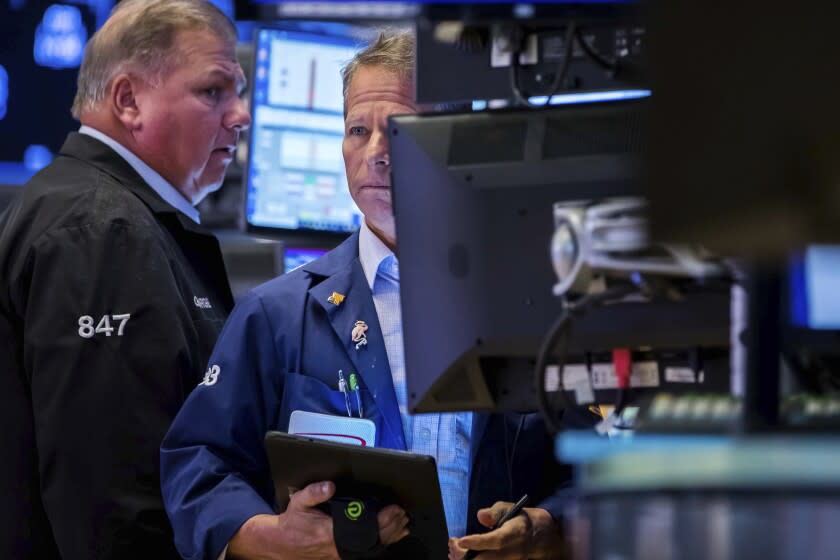Stocks slip on Wall Street as messy May comes to a close

Stocks closed lower Tuesday and the market eked out a tiny gain for May, a fitting end to a tumultuous month as worries about a possible recession, inflation and rising interest rates bruised Wall Street.
The Standard & Poor's 500 index fell 0.6%, having recouped about half of its loss from earlier in the day. The Dow Jones industrial average fell 0.7%, while the Nasdaq composite slid 0.4%. Both also pared some of their losses after falling at least 1.4%.
Such swings should perhaps be no surprise given Wall Street’s action this month, amid some of the wildest trading since the early days of the pandemic. The S&P 500 finished the month with a gain of less than 0.1%, which followed an 8.8% slump in April. The index is now 13.9% below its record set early this year. But the slight move for the month belies sharp lurches down and up that shook investors along the way.
Through mid-May, the S&P 500 suffered seven straight losing weeks, its longest such streak since the dot-com bubble was deflating two decades ago. Signs of slowing in the U.S. economy heightened worries that high inflation will force the Federal Reserve to raise interest rates so aggressively that it will cause a recession.
Some high-profile retailers also said inflation is eating into their profits, adding more urgency to the concerns. They all combined to bring Wall Street to the brink of a bear market as the S&P 500 was on the verge of closing more than 20% below its record.
“Outside of a peace agreement in Ukraine, it’s difficult to construct a case for more than a bear market rally,” which would be just a temporary turn higher for stocks, Morgan Stanley strategists led by Michael Wilson wrote in a report. They said that the more stock prices rise, the more likely the Federal Reserve will be to hike interest rates.
The S&P 500 fell 26.09 points to 4,132.15 while the Dow lost 222.84 points, closing at 32,990.12. The Nasdaq dropped 49.74 points to 12,081.39.
Smaller-company stocks fell more than the broader market. The Russell 2000 slid 23.85 points, or 1.3%, to 1,864.04.
Trading has been turbulent in recent weeks amid worries about a possible recession, inflation and rising interest rates.
Highlighting the worries about inflation, oil prices briefly rose Tuesday after the European Union agreed to block the majority of oil imports from Russia because of its invasion of Ukraine. Benchmark U.S. crude fell 0.3% to $114.67 a barrel. Brent crude, the international standard, rose 1% to $122.84 a barrel.
The jump of more than 50% for oil prices this year has been a big contributor to the very high inflation sweeping the world. Earlier Tuesday, a report showed that inflation in the 19 countries that use the euro currency hit 8.1% in May, the highest level since records began in 1997.
In the U.S., President Biden met with Federal Reserve Chair Jerome H. Powell as high inflation continues to eat into Americans’ earnings.
Their meeting was the first since Biden renominated Powell to lead the central bank and occurred weeks after the Senate confirmed his second term.
“My plan to address inflation starts with a simple proposition: Respect the Fed, respect the Fed’s independence,” Biden said.
Stocks have managed to avoid a bear market, at least so far, with the S&P 500 yet to close more than 20% below its record. The S&P 500 is coming off its best week in a year and a half, in part on hopes that inflation may have hit its peak and will begin moderating. Speculation has grown that the Fed may consider a pause in rate hikes at its September meeting.
Relaxing pandemic restrictions in China have also helped, easing some of the worries about the world’s second-largest economy and about more snarls in global supply chains.
China's factory activity contracted again in May, but it's almost back to growing. More factories, shops and other businesses are being allowed to reopen this week in Shanghai and in the Chinese capital, Beijing, after authorities declared outbreaks under control.
Stocks in Shanghai and Hong Kong rose more than 1%.
On Wall Street, healthcare, technology and energy stocks were among the biggest drags on the market. UnitedHealth Group fell 2%, Adobe dropped 2.7% and Chevron slid 2%.
Some areas of the stock market that have been hit particularly hard this year also climbed, including internet-related stocks. Amazon rose 4.4%, and the Class A shares of Google's parent company, Alphabet, gained 1.1%.
U.S. Treasury yields rose after reports showing confidence among U.S. consumers was higher than economists expected and home prices rose more than forecast.
The yield on the 10-year Treasury climbed to 2.85% from 2.75% late Friday.
Starting Wednesday, the Fed will begin allowing some of the trillions of dollars' worth of Treasurys and other bonds that it amassed through the pandemic to roll off its balance sheet. Such a move should put upward pressure on longer-term Treasury yields, and it's one of the ways the Fed is trying to stamp out inflation by slowing the economy.
AP Business Writer Elaine Kurtenbach contributed to this report.
This story originally appeared in Los Angeles Times.

